Article Archive
The Internet for Thermographers
MeasurementMedia
Inc.Southampton, PA 18966Abstract
In 1996, Brian Thomas, a well-known staff member at SPIE, published a book entitled “The Internet for Scientists and Engineers” describing the many communications tools and resources available via the internet. He published several others books and the field of internet information has never looked back. Some of his work has helped put SPIE at the forefront of digital technology in professional society services. The internet has changed dramatically since that first book and today it offers tools and resources for technically oriented professionals that literally defy description.
This paper will summarize a few of the specialized ones specially available for infrared thermographers as well as some more general purpose ones that can save time, enhance communications and help expand a small business as well as educate everyone.
Introduction
Brian J. Thomas at the Society of Photographic & Instrumentation Engineers, known today as SPIE, was a visionary who appreciated the resources available via the Internet as early as 1996. He wrote several books about it, the earliest being “The Internet for Scientists and Engineers”. Another, “The World Wide Web for Scientists and Engineers”, appeared in 1998.
These served as one of the earliest resources for budding Internet users and publishers in the area of technical information. His books discussed not only the mechanics of searching the Web and creating Websites, they related the differences between the “Big Six” search engines of the time: Alta Vista, Excite, HotBot, InfoSeek, Lycos and Yahoo.
Note that Google wasn’t even worth a mention in 1998, only 10 years ago!
Thomas’ book was and still is a valuable resource in many ways, with extensive listing of subject-specific websites that focus on narrow topics like Aerospace, Biology, Chemistry, Engineering, Geology, Imaging, Material, and so on. Many of the sites listed in his 1998 book are still online and are even more informative than before.
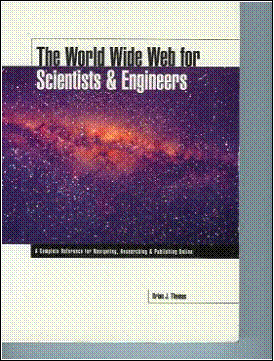
Although he didn’t anticipate the rise of Google and Microsoft, Thomas did recognize that the Internet, especially the Web, was subject to rapid change in content and possibly structure. He was so right that his view is still quite remarkable.
The Web pervades the Internet, and through it, Society and Technology, as most are aware. Today, many seem to have forgotten there is much more to it than just websites. Email is still one of the biggest applications on the Web, but Webmail has almost made the old email clients redundant.
File Transfer Protocol, or FTP, a means for rapidly moving files between computers over the Internet, has been relegated almost exclusively to the use of program and activities of web site publishers and programs like Dreamweaver, FrontPage, and others.
Discussion
It’s All About the Web
The World Wide Web, or simply The Web, has morphed in ways that few, even Brian Thomas, could imagine even just a few years ago, let alone ten years ago. The tools and resources available for everyone, especially those with a technology bent, are truly revolutionary. It is the Internet, now.
More and more of the present Web initiatives are driven by Open Source software and activities available through Open Source-related or Open Source-like organizations.
Wikipedia (www.wikipedia.org), the Open Source Encyclopedia, for one, is fully Open Source. Open Source usually means free software, including the source code, and the software is maintained and updated by a community of dedicated volunteers. It’s the way the Web started and the way, I believe, it was meant to be by its founders.
The software that powers Wikipedia, MediaWiki (www.mediawiki.org), for example, is free. Wikipedia’s content is nearly all donated by volunteers and has the answer to many of the questions that people ask about almost everything.

What is a Wiki, you ask? A “wiki” is software that allows users to create, edit, and link web pages easily. Wikis are often used to create collaborative websites and to power community websites.
The Web offers resources far beyond search, or Wikis. Yet, search is the key to getting started from scratch in many areas.
Specialized Directories are flourishing in many areas; some with information, graphics and technical resources just for those involved in Infrared. Even novices (newbies on the Web) can get a great, free tutorial on the physics of infrared courtesy of NASA at Caltech on CoolCosmos.
Web Tools
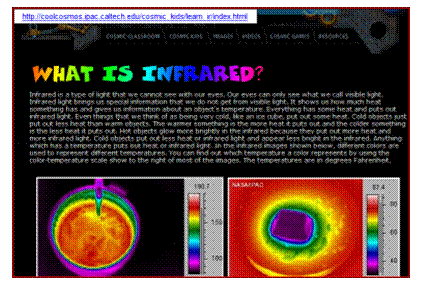 The Internet tasks associated with email have changed dramatically, too. The email Web interface offered at no cost by Microsoft (HotMail), Yahoo (Yahoo Mail) and Google (Gmail) provide ease of use with a web browser interface.
The Internet tasks associated with email have changed dramatically, too. The email Web interface offered at no cost by Microsoft (HotMail), Yahoo (Yahoo Mail) and Google (Gmail) provide ease of use with a web browser interface.
They also offer large, free, online storage capabilities and filtering for spam and unwanted and spurious emails. These aren’t quite Open Source applications, but they come pretty close. They are free, too. They’re not alone; just google the term “free email” to find even more email resources.
Modern design Web browsers can handle FTP tasks if you know how to FTP. Filezilla is a free, Open Source FTP client application, much like its older sibling, Mozilla and its spin off, Firefox.
Mentioning Web browsers brings up two interesting facts: Firefox is the only major competitor to Microsoft Internet Explorer (IE) and Apple Safari. It and Opera, another free browser, are both available for use in all operating systems: Windows, OS-X and Linux. However, IE only works with Windows and Safari only works with Apple products.
Speaking of Linux, did you know that more than half of all websites are run on servers powered by Open Source Linux (www.linux.org) and the Open Source Server Software, Apache (www.apache.org)?
That’s not really news; Apache has been around since The Web’s early days. Microsoft Web Server software has made a serious dent in Apache’s dominance, but a recent turn-around in that trend has been noted. Apache is increasing its dominance! (Note: Apache runs under the Linux OS).
In its October 2007 web server survey, Netcraft (www.netcraft.com) reported that, of the Web’s top ten hosting organizations, four ran under Linux, three ran under FreeBSD (www.freebsd.org), another Open Source Operating System, and only two ran Windows Server 2003.
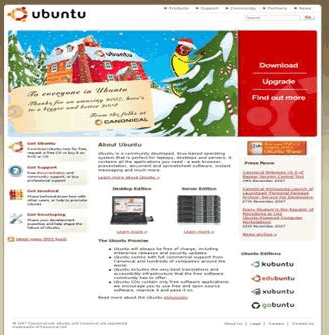 Linux itself has made some significant strides and the latest, user-friendly version, Ubuntu 7.10, (www.ubuntu.com) is available free on the Web and is supported by thousands of Open Source developers.
Linux itself has made some significant strides and the latest, user-friendly version, Ubuntu 7.10, (www.ubuntu.com) is available free on the Web and is supported by thousands of Open Source developers.
Ubuntu is a viable alternative to Windows and there is readily available virtualization (VM) software that enables one to run Windows applications under Ubuntu Linux (as there is VM software to run Windows under Intel-powered Apple computers).
What is even more remarkable is that Ubuntu comes with things like Open Office, a full-featured, Open Source alternative to MS Office. All the components of it are capable of reading and writing MS Office files. Even more remarkable is the fact that the text for this presentation was written using Open Office Writer. Visit www.openoffice.org to learn more.
Speaking of Open Source software reminds one that there are literally thousands of free and very capable open source packages available for download that run under Linux. Not the least of these is GIMP (www.gimp.org), an image graphics program with more features than PhotoShop Elements and almost as capable as PhotoShop itself!
Instant Messaging (IM) and online Chat are ubiquitous and free, too! One can write and “Chat” at the same time on the same computer. They’ve been around quite a while.
The latest wrinkle is Skype, free computer-to-computer telephony, where you can literally talk while you IM and work with another who has Skype on their computer…anywhere in the world. You can even video chat using Yahoo’s IM, Skype and Apple’s Chat feature in iLife.
Skype has almost revolutionized telephony for business on a national and international basis. Not only can one talk clear and free between computers, one can call normal telephones anywhere in the USA with Skype-out for about $40 per year in the USA or call overseas phones for a few cents per minute.
With Skype-in you can have a presence in any state or many foreign countries with a redirected telephone number to any phone you select, at modest costs. Not only does it work – it works very well.
Online productivity tools like Google Docs put a very functional word processor and spreadsheet set of software online, free and with free data storage and many other features. It means you can access your documents or spreadsheets literally anywhere that you have Web access.
Zoho.com takes this concept several steps further. It offers presentation development, database and several other office tools in addition to excellent word processor and spreadsheet applications.
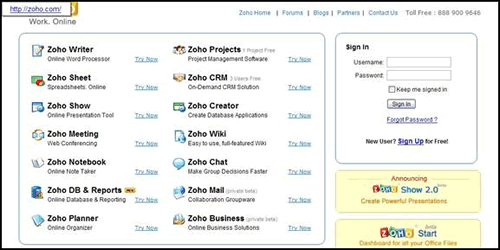
Social Networks, Blogs & RSS
MySpace, Facebook, and a lot more, are easy ways for millions of people to connect on the Web.
There are lots of other social networks on the Web; one of the most unique and one I like is Ning (ning.com). Ning allows one to setup a public or a private social network for free. Rather revolutionary stuff since the graphics are professional and one can end up with essentially a very sharp-looking website for your group, whether it is the Thermographer Congress of Upper Manhattan or The Kumquat Packers of America.
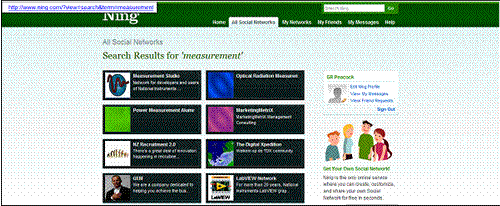
Social Networks, Chatting, IM, YouTube, Blogs, RSS and Net Meetings seem to rule the newer aspects of the Web. However, Free seems to be the growing rule, almost like an extension of Open Source.
What does it all mean and where can a thermographer and small businessmen find utility and business or technology advantages using the Web? Certainly, low cost telephone service helps, especially in doing telephone surveys and sales prospecting.
Do any of these new tools make it easier or harder to do business and grow a technical business like that of a Thermography Service organization? You bet it does – and more than ever! It truly boggles the mind with the breadth & depth of “Stuff” and “thingies” out there ready to help and/or distract one.
Blogs are everywhere and they are free in most places. There are millions of them and hundreds of thousands are created daily. They offer anyone a chance to be “on the Web”, free and with ease.
A blog (short for Web Log) is like a journal and/or a news media. They contain regular “postings” or “Posts” of content that are entered in sequential fashion, much like a diary or journal. Initially started as a communications tool, they have been used as everything from literally online personal journals to highly respected journalistic news outlets, e.g. www.thedrudgereport.com. But, the capability and usage have gone far beyond mere journaling or stream of unconsciousness (there’s lots of that out there).
Blogs come in basically two different forms. The first is an online, free website composed of multiple blogs, like Blogger.com. In those cases, one gets a URL something like johndoe.blogger.com, rather than a fully personal domain name. The second is a stand alone web site with your own domain name, like johndoe.com, that uses blogging software from a third party like the popular WordPress, Textpattern, b2evolution or TypePad & MoveableType. The first three are free software while TypePad and many others cost money, some less than others.
The Free approach is growing and expanding widely, especially in the Blogging area. The commercial blog software company SixApart (sixapart.com), that sells TypePad (and Movable Type) software offers both VOX, a free, online Journal with which one can express themselves or sell people on the subject most dear to their heart. It’s not Open Source, but it is free; and Live Journal is another free outlet on the Web also with blogging capability.
WordPress.org (Note: the free software side of WordPress.com) offers popular, free and widely supported stand alone blogging software.
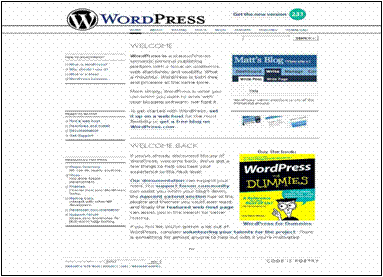 While sites like Facebook, VOX and Ning help one generate a web presence easily, and could for you, an Open Source WordPress-based website with your own domain name could do even better for your company and enable you to maintain full control.
While sites like Facebook, VOX and Ning help one generate a web presence easily, and could for you, an Open Source WordPress-based website with your own domain name could do even better for your company and enable you to maintain full control.
The free blogging software from WordPress is actually a type of Content Management Software system, if you wish to use it that way.
You can have static content pages and dynamic “blog entries” or news articles, if you wish. All searchable and easy to configure for someone with only modest know-how in web programming.
We, for instance, now operate five separate websites, some of which I’ll describe below, that use WordPress. We are even in the midst of an upgrade to our main website, About Temperature Sensors (www.temperatures.com), using WordPress too. WordPress is versatile and very capable website software.
Some Web hosting companies offer low cost hosting packages that provide free installation of WordPress and similar software with several hundred gigabytes of server storage useful for thermal image galleries at 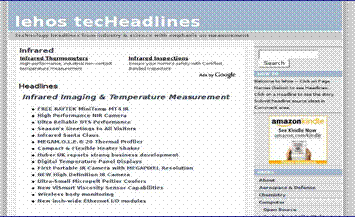 modest prices. So, getting a Web presence today is easier and lower cost than ever before!
modest prices. So, getting a Web presence today is easier and lower cost than ever before!
RSS (Really Simple Syndication) is one of the tools developed for blog software that enables easy sharing of content, especially article and story headlines, but one can also include images, podcasts and video. It is nearly everywhere, including the news headlines from the Infraspection website (www.infraspection.com), the only one in the IR training field, BTW, and many of our own websites.
You are free to put news links right on your website. One of our websites is all news headlines from about 40 selected Web RSS feeds, lehos.com.
Video and Image Sharing
Video is everywhere on the Web today, it seems. Probably everyone has visited YouTube.com at one time or another. It is a very mixed bag.
Interestingly, some companies are using YouTube as a place to release publicity about their new products or applications for them. Flir Systems is one of the biggest participants!

It is growing in popularity and while much of the content seems to be a waste of space, it has great potential as a new marketing tool, educational tool and, in general, a way to improve B2B communications as well as interpersonal communications.
Webcams are everywhere, and the technology advances from YouTube and others make video more accessible. It is possible to have free web space and upload digital images, still photos and videos to process, organize, and/or share. That’s been around for years with tools from Google and Yahoo and others like Flickr, Picassa, and Snapfish.
Today, you can upload your MS PowerPoint presentations, view them on the Web, and/or embed them from one website into another Web page. SlideShare.net is a free resource for anyone and ScreenCast.com offers even more, including audio, but at a cost.
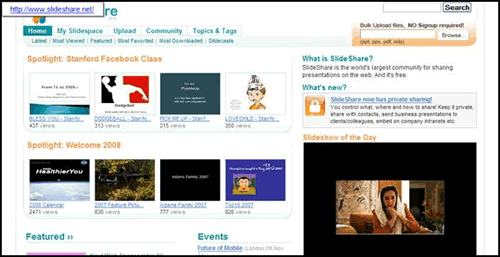
Web Infrared Libraries
There is a virtual library of web information relating specifically to infrared applications and resource information that can be of use to thermographers. It is but one aspect of our vision that all you need to know is on the Web…..somewhere.
You just have to find it or someone who has been organizing it. Lots of people have been doing just that: organizing technical information and resources about Infrared Thermography on the Internet. It’s not all free, but a great deal of very useful resource information is.
In my view, it starts with the Infraspection IR/INFO archives of their “Tip of the Week”.
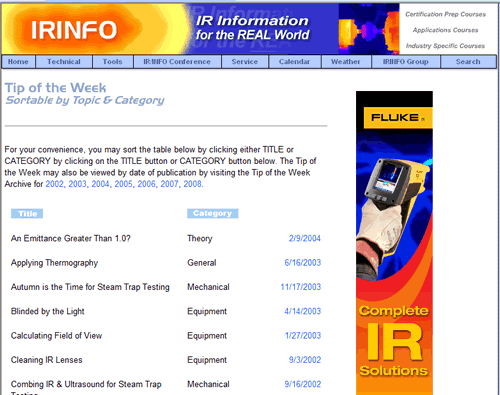
All the major IR training organizations offer some information online and various thermal image galleries. All also offer back copies of their Conference proceedings for sale at nominal prices on their websites.
ITC offers a free, monthly email newsletter with lots of interesting and useful information for thermographers. Their online archives are available without charge.
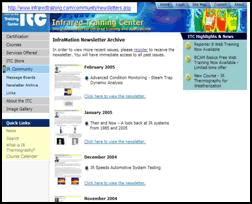
While several messaging boards have been online for some time, the new IRTalk.com by Snell Infrared Group is the slickest implementation I’ve seen to date.
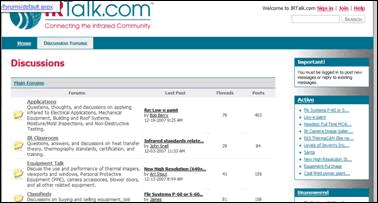
Our website, TempSensor.net, a set of free vendor and resource directories, has cataloged many free technical articles available for either online reading or as free downloads. They are listed on TempSensor.net, right on the front page.
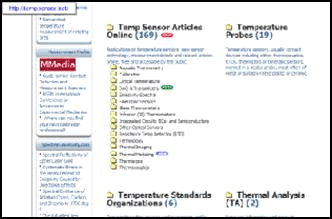
In 2007, we introduced two new websites as free community resources. Both offer easy commenting and inputs from the community of Thermographers worldwide.
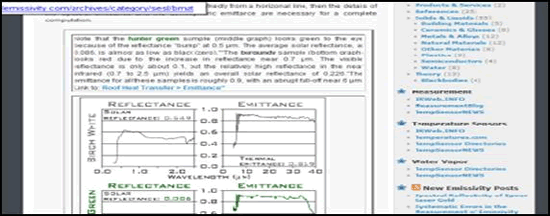
The first site, IRWeb.Info, is devoted to IR Thermometry and IR Thermography applications, and is a more focused extension of the articles concept on TempSensor.net.
The second site, SpectralEmissivity.com is even more focused on the complex subjects and details of Spectral Emissivity and Emittance, and how it is measured and reported. We catalog more and more data every week from sources on the Web, volunteer inputs, and my personal emissivity library.
If you have difficulty believing that we’ve chosen a term for the title of the emissivity site that is too long, check out the Emissivity basic education pages on About Temperature Sensors (www.temperatures.com/eindex.com). It’s been online for more than seven years now.
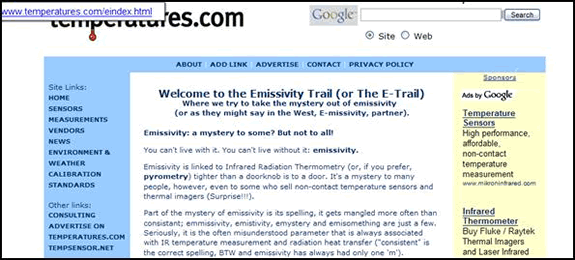
Then too, there is some interesting and very useful information on infrared applications on a host of websites, but we believe that the searchable applications repository on IRWeb.Info will be the long term winner simply because by being independent, we have no problem cataloging the listings on the websites of competitive organizations.
USA and overseas government websites are ripe places to locate key information about applications. The US Department of Energy has active IR groups at Lawrence Berkeley Labs, Oak Ridge National Labs and Sandia Labs, to name just a few.
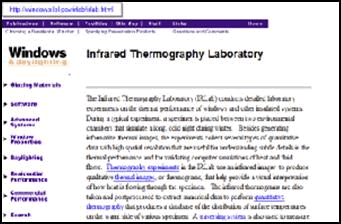
I could go on and on about resources, but the ones listed here are useful indeed and can lead you to many, many more.
Conclusion
Bottom line
The Web is a great tool for business, for education, and for sales and marketing. It is maturing and there are literally mountains of useful information buried in a planet-sized landfill of unrelated data. We are sorting out some of it, as are others.
It is literally amazing to see the creative options being offered today that offer free and reasonably priced tools and resources for business, especially those in technology-centered professions like Infrared Thermography.
We barely scratched the surface here. We’ll be adding useful features to our various websites as we find and adopt them and perhaps update the IR/INFO attendees. If you know of any resources, articles, links specific to thermography or measurement in any area, please share. One of our websites, entitled MeasurementBlog.com, is operated like a true blog. It is open to all.
We encourage feedback and you are more than welcome to enter a suggestion or comment at any time.
All our websites are free and, if one has a registration option, that is free, too. Our business model, like Google’s, is based on advertising. So, you’ll see ads on most of our websites. Our advertisers, including Infraspection, make it possible for you to access our sites at no charge.
Visit out Sponsors:
Electrophysics



Advertisement



